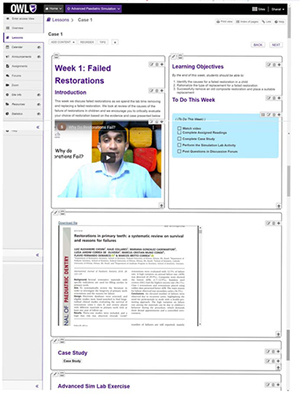Feature: The knowledge multiplier - creating an online clinical learning experience
By Emily Leighton, MA'13
Dr. Sharat Pani calls it the perfect storm – the moment earlier this year when his interest in technology and online learning collided with the COVID-19 pandemic.
With restrictions disrupting the clinical learning environment for dental students, the paediatric dentist and Assistant Professor looked at the situation as an opportunity to innovate.
“It was an unknown, evolving situation and we needed new ways to interact with students; to teach clinical skills without the standard access and structure of the clinic,” he said.
Dr. Pani found an enthusiastic collaborator in Dr. Liliani Vieira, Chair, Division of Paediatric Dentistry. Together, they developed a blended learning model in paediatric dentistry, combining online and in-person components.
In July, 76 dental students participated in a pilot program for the learning model. The online component was delivered via OWL, the University’s online learning management system. With physical distancing measures in place, students also attended in-person simulation clinics in small groups of six.
The researchers reported on the pilot program in recent publication for the Journal of Dental Education.
“It was a challenge to transfer the learning that takes place in the clinic to an online format, but we were able to rely on existing tools and modify them for clinical instruction,” explained Dr. Vieira.
A strong pedagogical foundation was an important starting point. The educators focused on the well-established BOPPPS method to help align learning outcomes with the selected activities and assessments.
 Each week, students started their learning online, with an introductory video, an article to read, a case scenario and a simulated lab exercise. The following two-hour, in-person clinic session was divided into a case presentation, simulated clinical exercises, restorative exercises and a group discussion.
Each week, students started their learning online, with an introductory video, an article to read, a case scenario and a simulated lab exercise. The following two-hour, in-person clinic session was divided into a case presentation, simulated clinical exercises, restorative exercises and a group discussion.
The learning concluded online with a forum discussion in OWL. Students were also asked to summarize the reading and the impact it had on their choice of restorative material or technique.
“This model doesn’t replace in-person clinical learning, it augments it,” said Dr. Pani. “The online environment acts as a knowledge multiplier; we can now share and discuss cases with the entire class, instead of being limited to only those students who are in the clinic on a specific day.”
Drs. Pani and Vieira are quick to acknowledge the support and expertise they received during the development process, including resources from the Centre for Teaching and Learning, Western Technology Services and the Schulich Education Enhancement Division. Drs. Bertha Garcia, Vice Dean & Director, Dentistry, and Richard Cherry, Associate Dean of Learning with Technology and Simulation, also provided valuable support and guidance.
“It’s such a positive example of the different branches of our institution coming together to enhance the student experience,” said Dr. Pani.
As part of the pilot program, Drs. Pani and Vieira asked for qualitative feedback from participating students. They used the students’ suggestions to update the program for the new academic year, including a uniform template for all Schulich Dentistry courses in OWL and expanded opportunities for live discussions via Zoom.
They also plan to collect quantitative data to better understand how the blended learning model impacts knowledge retention and technique.
Beyond the COVID-19 pandemic, Drs. Pani and Vieira consider blended learning the way of the future for clinical instruction. “The pandemic hastened the transition to this blended model, and now that we’ve evolved, I believe it’s here to stay,” said Dr. Pani. “It creates so many efficiencies and really supports the idea of the educator as a facilitator of knowledge, rather than a vessel or holder of knowledge.”
After publishing their report, the researchers have received positive feedback and inquiries from dental educators across Canada and around the world. “The process and the framework we developed is transferable to many different tools and platforms, so we are excited to make these connections” said Dr. Vieira.
They also hope the pilot program inspires other educators at Western. “We’re extending an open invitation,” said Dr. Pani. “Our doors are open; we’re happy to share what we’ve learned and collaborate.”








